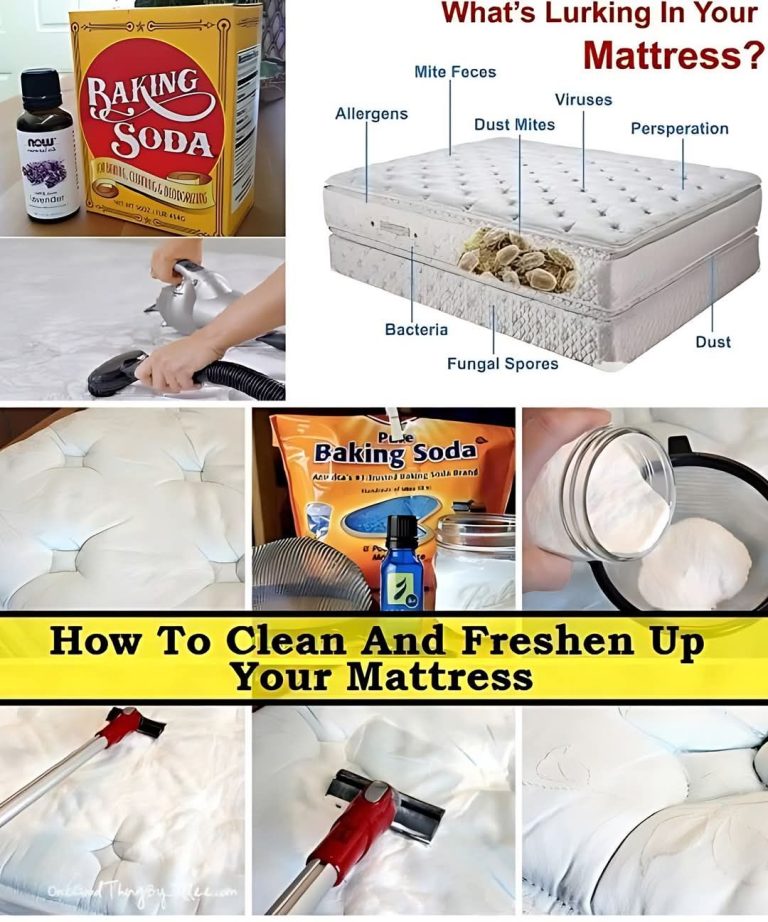ADVERTISEMENT
See also Garlic and Honey: A Powerful Home Remedy for Better Health
It’s important to remove the powder thoroughly to avoid any buildup or grittiness when you replace your sheets.
Additional Tips for Maximum Effectiveness
Repeat Monthly: Use this refresher once every 3 to 4 weeks for best results, or more frequently during hot, humid months.
Use Fresh Baking Soda: For maximum deodorizing power, make sure your baking soda hasn’t expired or absorbed odors from your pantry.
Clean Mattress Stains First: If you have visible stains, spot clean with a mixture of water and mild detergent before applying the baking soda.
Store Extra Mix: Double or triple the recipe and keep it sealed in a cool, dry place for quick future use.
Don’t Overuse Oils: Too much essential oil can cause overpowering scents or minor discoloration on light fabrics. Stick to 4–5 drops per cup.
Natural Variations and Upgrades
If you want to take this DIY even further, consider these enhancements:
Add cornstarch: Mix in ¼ cup of cornstarch for added moisture absorption.
Use a shaker bottle: Repurpose a Parmesan or spice shaker for easier application.
Layer scents: Mix lavender and eucalyptus for both calming and refreshing effects.
Include dried herbs: Dried lavender or chamomile buds add texture and scent.
FAQs
Can I use this on memory foam mattresses?
Yes. This refresher is safe for memory foam, latex, and traditional spring mattresses. Just ensure it’s vacuumed thoroughly so powder doesn’t build up in foam cells.
How often should I deodorize my mattress?
Once a month is ideal, but you can refresh more often if your mattress is exposed to pets, children, or spills.
Will baking soda leave a residue on the mattress?
Not if you vacuum thoroughly. Use a brush attachment and go over the mattress a few times to pick up all the powder.
Can I use any essential oil I like?
Absolutely. Just avoid oils with dark colors or sticky residues (like patchouli), which may stain light-colored fabrics. Always use high-quality essential oils.
Does this kill bacteria or dust mites?
Essential oils like tea tree and eucalyptus have antimicrobial and dust mite-repelling properties. While it’s not a substitute for deep disinfection, this DIY does reduce the bacterial and fungal load on the mattress surface.
Is this safe for babies and pets?
It depends on the oil used. Avoid strong oils like peppermint or eucalyptus near babies and small pets. For baby mattresses, use baking soda alone or consult your pediatrician before applying essential oils.
Can I skip the essential oil and just use baking soda?
Yes. Baking soda alone will still deodorize and absorb moisture. The oil simply enhances the scent and adds mild antimicrobial benefits.
Conclusion
Refreshing your mattress doesn’t require a trip to the store or a professional cleaning service. With just baking soda, essential oils, and a vacuum, you can create a simple, affordable solution that keeps your bed smelling clean and promotes restful sleep. Whether you’re dealing with lingering sweat smells, dampness, or general stale odor, this natural refresher gets the job done—without toxic chemicals or synthetic fragrances.
Plus, the calming scent of essential oils like lavender can turn your mattress-cleaning routine into a soothing, spa-like experience. Try it once, and it might just become part of your regular bedroom upkeep.
DIY Mattress Refresher Recap
Supplies Needed:
1 cup baking soda
4–5 drops essential oil (lavender, tea tree, eucalyptus, etc.)
Jar with lid
Vacuum cleaner
Instructions:
Mix baking soda and essential oil in a jar.
Shake well to blend the mixture evenly.
Sprinkle over your mattress.
Let it sit for at least 1 hour.
Vacuum thoroughly.
Time Required: 10 minutes prep, 1–2 hours wait
Skill Level: Beginner
Method: Natural deodorizing powder
Best For: All mattress types
Use Frequency: Monthly or as needed
ADVERTISEMENT
